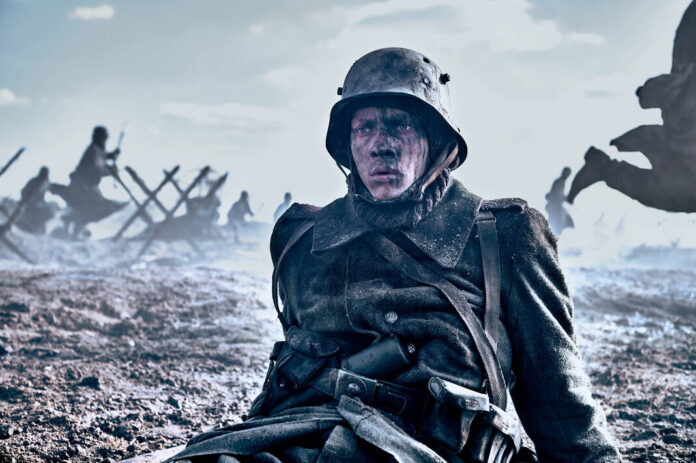“All Quiet on the Western Front,” a 1928 World War I novel by war veteran Erich Maria Remarque, was banned and burned in Nazi Germany. When the Academy Award-winning 1930 film version from Universal Pictures opened in Berlin, Joseph Goebbels himself entered the theater and started a riot. In 1979, a second version of the film was seen on American TV. Now, we have a version from Germany itself, and the film is the country’s selection for the Academy Award. I don’t know much about director Edward Berger, whose previous film “Jack” was about a troubled family. But his version of “All Quiet on the Western Front” is at least the equal of Lewis Milestone’s early talkie classic.
His lead actor Felix Kammerer, who plays the lead Paul Baumer, has a haunting, terrified, shattered expression on his face throughout most of the film, a look that is going to stay with me for a long time. Several times, that face is caked in mud and resembles a death mask. As in all film versions of this book, Paul is one of a close-knit group of young men, some still adolescents, who are encouraged to join the fight by a teacher who delivers a war-mongering speech resounding with themes and images from the St. Crispin’s speech of Shakespeare’s “Henry V.” Not knowing what awaits them, they sign up and literally wearing the clothes of dead men they are soon in the trenches at the Western Front.
Like all great war moves, “All Quiet on the Western Front” is fiercely anti-war and frequently repulsive to look at. “Man is a beast,” someone observes. “I want to go home,” cries another. The war is a meat grinder, turning human bodies into blown-to-bits bloody rags with bullets, bombs, tanks, artillery shells and grenades. In one scene, French soldiers armed with flame throwers burn German soldiers alive. One by one, Paul’s beloved friends are killed in terrible ways. In another horrifying scene, Paul is pulled out of the blasted earth like a man being dragged out of his grave. How long will this innocent evade Death? Someone in the German High Command says that 40,000 German soldiers were killed in a week. In Champagne, France, a German soldier steals a goose from an angry French farmer, and he and his friends cook it and wolf it down. Camps are full of surgeons in blood-soaked coats, sawing the limbs off the injured without anesthesia. Caskets are piled everywhere. Bodies are thrown into holes in the ground. A maimed friend of Paul’s, who dreamed of being a Ranger, stabs himself in the neck repeatedly with a fork. Meanwhile, on a train full of food and drink, diplomats led by a consul played by Daniel Bruhl, who also served as an executive producer, negotiate with an obdurate Marshall Foch. They rightly argue that the French armistice is designed to humiliate and impoverish Germany.
The war imagery in this “All Quiet on the Western Front” often recalls the work of Otto Dix, the German artist and WWI veteran, whose work realistically depicts the horrors of that war and the horrific wounds inflicted upon its fighters (the Nazis banned him, too). “All Quiet on the Western Front” surpasses even Sam Mendes’ Academy Award-winning WWI epic “1917” (2019) in its realism and immersive quality. The trench warfare scenes are something out of a horror film. We and Paul journey through a bloody, picaresque, rat-infested hell. We are reminded of the pain Putin inflicts right now in Ukraine. Cinematographer James Friend (TV’s “Rillington Place”) deserves as much praise as Berger. The baleful sonics of composer Volker Bertelmann (“Ammonite) are the perfect accompaniment. This new “All Quiet on the Western Front” takes liberties with the book. But Remarque would approve.
‘ALL QUIET ON THE WESTERN FRONT’
(In German and French with English subtitles)
Grade: A
MPAA rating: R (for strong bloody war violence and grisly images)
Running time: 2:27
How to watch: Now in theaters and streaming on Netflix Oct. 28.







